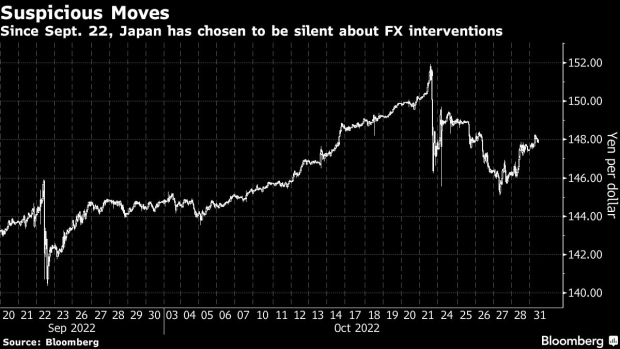Oct 31, 2022
Japan Spent $42 Billion in October to Prop Up Yen in Markets
, Bloomberg News

(Bloomberg) -- Japan spent a record 6.3 trillion yen ($42.4 billion) in October to counter the yen’s sharp slide against the dollar, as it tried to limit speculative moves adding to pressure on the currency.
The finance ministry disclosed on Monday data for the period between Sept. 29 to Oct. 27. Central bank figures and market estimates of money flows with the government had suggested that a suspected intervention on Oct. 21 cost around 5.5 trillion yen ($37.2 billion).
Other moments of high volatility including a sharp move on Oct. 24 have kept traders guessing over how often authorities have been operating in the markets and how long they can continue to support the currency.
“Japan should still have more than 10 trillion yen left in cash, so big interventions at the level we’ve seen in September and October could happen maybe another three to five times,” said economist Atsushi Takeda at Itochu Research Institute.
He said the October figure came in largely in line with his 6 trillion yen estimate for interventions on Oct. 21 and 24, plus additional smaller entries into the market.
Tsuyoshi Ueno, a senior economist at NLI Research Institute in Tokyo, had expected a figure around 7.5 trillion yen.
“It seems their stance isn’t to move too often but to choose the right moment that will have the most impact,” Ueno said, comparing the current strategy with repeated daily interventions in 2004 and 2011.
The government has chosen to remain silent over direct market action in the past month or so, a strategic shift after it announced its first yen-buying intervention in 24 years on Sept. 22. The 2.8 trillion yen move in September failed to reverse the yen’s falling trend, and the currency dropped to almost 152 against the dollar before its sharp surge on Oct. 21.
The yen was around 148.57 per dollar on Monday evening in Tokyo.
Japan had about $1.24 trillion worth of foreign reserves as of the end of September, according to the finance ministry. Among its most liquid foreign reserve assets are deposits amounting to $135.5 billion with foreign central banks and the Bank for International Settlements.
Still, Masato Kanda, the finance ministry’s top currency official, has said resources for intervention are limitless. While refusing to comment on whether authorities have stepped into markets again, he’s kept up his warnings against speculative moves along with his boss, Finance Minister Shunichi Suzuki.
US Stance
“One thing to look out for is the US’s currency manipulation report,” said Takeda, flagging intervention of more than 2% of gross domestic product among criteria for the designation. “For Japan that’s around 11 trillion yen, so if that’s your upper limit Japan has maybe another 2 trillion yen left.”
Back in September, the US Treasury said it understood Japan’s first intervention. US Treasury Secretary Janet Yellen has declined to comment on reports that Japan has stepped into markets again since then. Kanda said last week that Yellen respected Japan’s stance of not disclosing its entry into markets.
The yen is expected to remain under downward pressure versus the dollar as long as interest rates continue to widen between the US and Japan. The Federal Reserve is poised for another major hike this week after the Bank of Japan stood pat on Friday.
But further ahead, signs of the Fed approaching a peak on rate hikes should work to ease pressure on the yen, Itochu’s Takeda said.
--With assistance from Erica Yokoyama and Yuko Takeo.
(Adds economist comments)
©2022 Bloomberg L.P.






